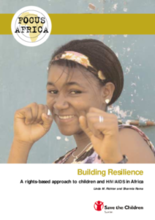HIV and AIDS have impacted severely on Africa and its children. The infection rate has risen rapidly and the scale of prevalence is largely unabated. Moreover, the epidemic compounds existing problems that children and families face resulting from decades of exploitation, poverty, civil and regional conflict, and natural disasters. UNAIDS data indicates that Sub-Saharan Africa remains the hardest hit region in the world, with a total of 25 million people living with HIV/AIDS.
Many children in Sub-Saharan Africa, in addition to those who receive most media attention (i.e. orphans, child heads-of-household, and children living with HIV/AIDS), are affected by HIV/AIDS, poverty, and social instability. They include already vulnerable children, especially children with disabilities and children living outside of family care, as well as children living with chronically ill or disabled adults, children in homes that have become poorer as a result of fostering in children from the extended family, and children in communities suffering a high burden of illness, dependency, destitution, and death. In all of these situations, children’s health, economic and food security, family life, connections to social institutions, opportunities to learn, human rights to development, and hopes for the future, are threatened.Responses to the HIV and AIDS crisis should recognise root-causes of the spread and impact of HIV and AIDS, including gender inequality, as a source of vulnerability. This report examines how a rights-based approach's underlying principles of universality, indivisibility, responsibility, and participation can provide a firm foundation for framing priorities and responses to children and families. Overview and analysis of major responses suggest the need for a wider, long-term, holistic approach. Substantial agreement exists amongst child-rights advocates that what is most needed is a set of collective governmental and community responses to strengthen the commitments of caregivers and households to the well-being of children.
The recommendations of this report include:
-
Build resilience
-
Engage government, stakeholders, and the children
-
Analysis-based strategic interventions
-
Address discrimination
-
Focus on caregivers
©Save the Children Sweden

